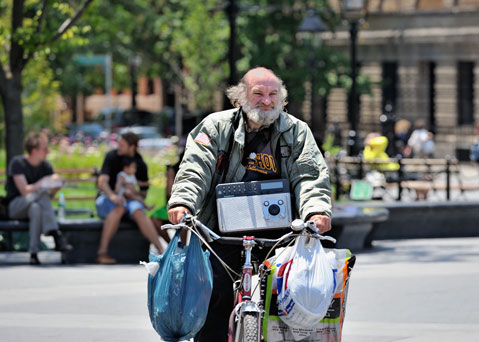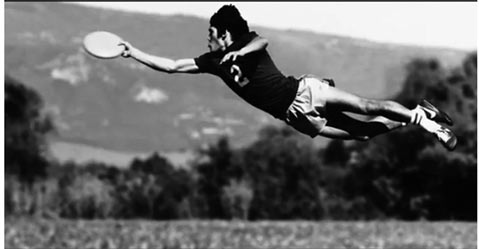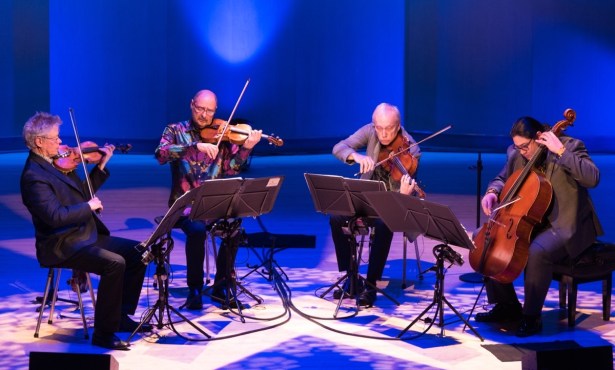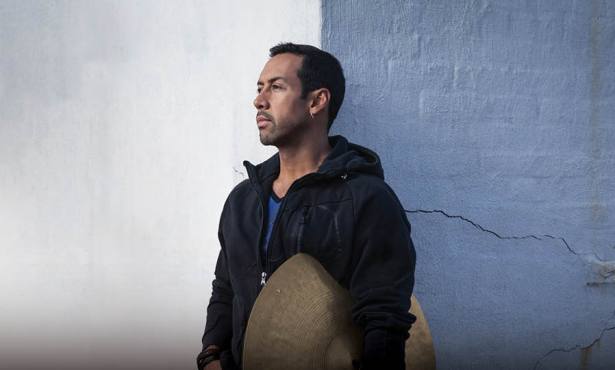Woodard: Radioman, Frisbees, and Dave Grohl
On What Makes a Celebrity, Santa Barbara's Disc Connection, and Sound City
Sure, we’ve come to love and expect our high-flying celebrity encounters at SBIFF over the years, catching sight and sound of actors and sometimes directors (i.e. Marty Scorsese last year and Quentin Tarantino on Wednesday) in the flesh in real time. But a funny thing happened this year when we ran smack into a celebrity as we hardly knew him, until we got the full story in Mary Kerr’s fascinating documentary Radioman. The former homeless man and reformed drunk from NYC who dubbed himself “radioman” is well-known in movie circles, as the avid pursuer of movie sets and screen ops at shoots around New York, mostly, a self-styled celebrity who was greeted as such when he showed up in person after the Monday afternoon screening, in all his funky, witty splendor.

Reportedly, for those of us heretofore sadly ignorant of this celebrity on the sidelines, Radioman has appeared in some 100 films, sometimes quite visibly, in countless movies, and stars know and often love him. Kerr gets passionate testimonials from the likes of George Clooney, Josh Brolin (who called him “very genuine and very adolescent, which is why I like him, he’s like me”), Johnny Depp (who described Radioman as “someone from another planet or an eccentric billionaire… or both”),and his fan and friend Robin Williams, among others. Scorcese and Spielberg have found bit roles for him, in The Terminal and Shutter Island. Kerr’s deft and disarmingly charming film tracks his movements, and touches on his own background, and follows him on a poignant trip to the Oscars in L.A., channeling questions about celebrity fetishism and other subjects along the way.
Post-screening, Kerr came down with Radioman, who got a standing ovation, and waved his box of Dots like a trophy, his signature portable radio strapped around his neck and an SBIFF cap on. He has been doing some touring festivals with the film, and has visited Dubai and is headed to Argentina, and has been tooling around Santa Barbara — by the bay and the “river” and elsewhere — on a Schwinn someone loaned him. “I’m staying at the Sandman Inn,” he told us. “I thought I was going to sleep forever.” He seemed to be soaking up the validating attention he’s receiving. “I’ve never gotten this kind of respect. Never….I think we’re all celebrities. We should all be famous.”
Later, as a random detour from the Q&A flow at hand, he made the observation that he noticed a lot of homeless people on the streets of Santa Barbara. “It’s sad to see,” he said, as one who has known that life. He then proposed the idea that the festival powers-that-be arrange a free screening of a film and invite in the homeless. At the end of the Q&A, some patrons started departing, and Radioman ended the session by saying, “Thank you for coming, and thank you for leaving.”

In another case of a documentary in which the real rubbed contextual elbows with the reel, Tuesday night’s screening of The Invisible String, German filmmaker Jan Bass’s fun and illuminating doc on Frisbee sports and lifestyle kicked off with the filmmakers lobbing film promotional mini-discs into the audience. In fact, Santa Barbara has figured strongly into Frisbee culture, via the world renowned ultimate Frisbee team the Santa Barbara Condors, and members of that team, and other Frisbee scene champions and notables were in the house.
Sound City, whose screening on Tuesday afternoon at the Lobero was the second U.S. screening after making a splash at Sundance, is one of the greatest rock documentaries I’ve ever seen, thanks to the passion and greater purpose of Dave Grohl’s directorial and personal vision. He brings a lot to the table here, tracing the history of the hit-factory-like yet funky Van Nuys studio which created classic albums from Fleetwood Mac’s Rumors to Nirvana’s Nevermind, with Tom Petty, Foreigner, Queens of the Stone Age, and countless others.
There is plenty of insider stuff here that musicians and fans of recording studios will slobber over, including a virtual protagonist role of a legendary mixing board, Sound City’s Neve Board, which Grohl eventually bought when the analog studio finally gave up the ghost, done in by Pro Tools and its digital ilk. The final segment of Sound City takes place in Grohl’s own studio, where he has gathered musicians to record an album in tribute to the grand old studio. His partners, recording live to actual analog tape through the godly Neve, include Rick Springfield (hey, that guy is surprising good!), Josh Homme, Trent Reznor, and the piece de resistance, a visit from Paul McCartney, which resulted in the spicy bluesy two-chord song heard on Saturday Night Live a few weeks back.
Voila! Grohl has his epiphanic moment, creating a new song with a Beatle who launched his passion for music as a kid, and using the board which he claims lured him deeply into music. In the sometimes dubious genre of rock films, Sound City rocks, big-time.
At midpoint through this year’s SBIFF, we get some altitude on the operation and the programming overview, and the going is generally strong this year. Here is one festivaler’s Top Ten Thus Far list of memorable films screened so far: Sister, Barbara, War Witch, Caesar Must Die, Sound City, About 111 Girls, The Deflowering of Eva van End, Radioman, NO, Clandestine Childhood.



